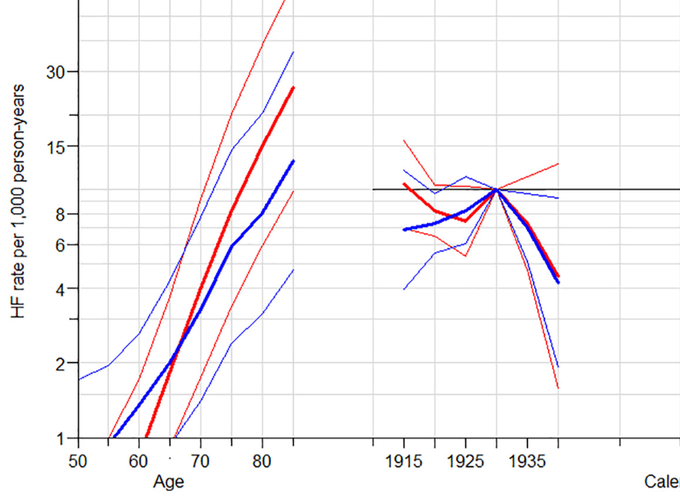Time trends in first hospitalization for heart failure in a community-based population
 Estimated effects and 95% confidence intervals for the incidence rate of first hospitalization for HF based on the APC models (women=red lines, men=blue lines). The age effect is on the left, the cohort effect is in the centre plot, and the period effect is on the right.
Estimated effects and 95% confidence intervals for the incidence rate of first hospitalization for HF based on the APC models (women=red lines, men=blue lines). The age effect is on the left, the cohort effect is in the centre plot, and the period effect is on the right.
Time trends in first hospitalization for heart failure in a community-based population
Abstract
Background: This study aims to assess time trends in first hospitalization for heart failure (HF) in a community-based population over the period from 1977 to 2014. Methods: Population-based cohort study using resources from the “Martignacco project” started in 1977 and promoted by the WHO. Three thousand and sixty-six subjects were involved in the project with follow-up through December 2014. Estimates were made for age-specific incidence rates for the first hospitalization for HF by birth cohort, calendar period, and gender. To disentangle the effects of age, calendar period, and birth cohort on the overall temporal trend in HF, we performed an age-period-cohort (APC) analysis. Results: An incident hospitalization for HF was reported for 427 subjects. In the APC model, a cohort effect with a turning point in 1930 was observed. After 1930, a sharp decrease in the rate ratios (RRs) occurred in among both genders. The estimated RR in the 1940 birth cohort decreased to 0.43, (95% CI 0.19–0.92), in men and to 0.45, (95% CI 0.16–1.26), in women. A residual effect of calendar period on RR was observed with a plateau in 1995 for women and in 2000 for men, followed by a decline. Conclusions: The current findings showed that HF hospitalization incidence has declined over the period considered in subjects over 65 years living in a geographically defined community in Northeast Italy. Moreover, the age of birth, calendar period of diagnosis, and birth cohort play an important role in the incidence of the first hospitalization for HF.